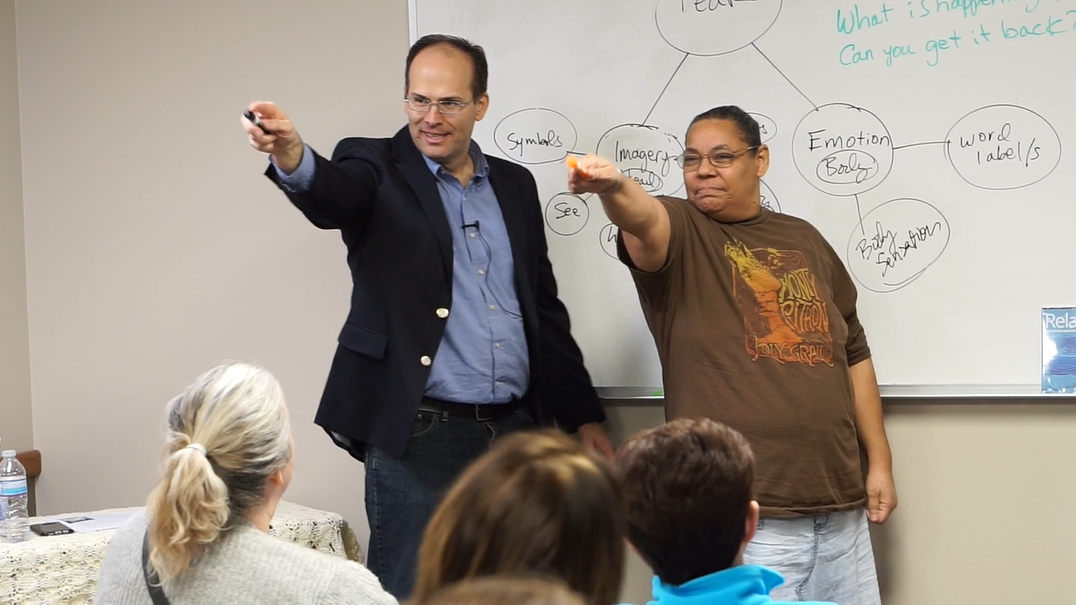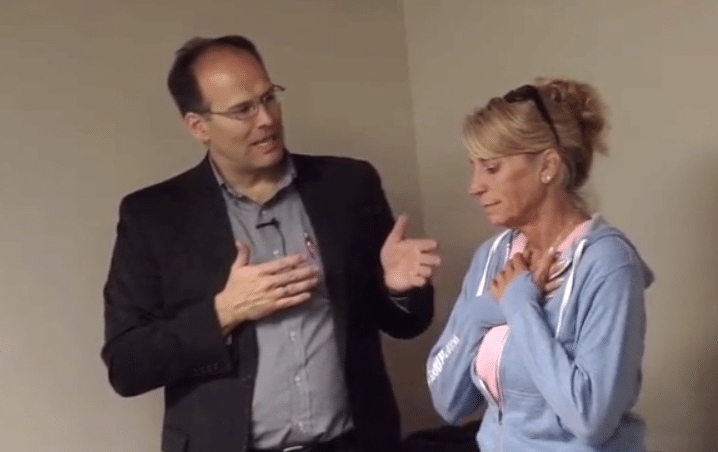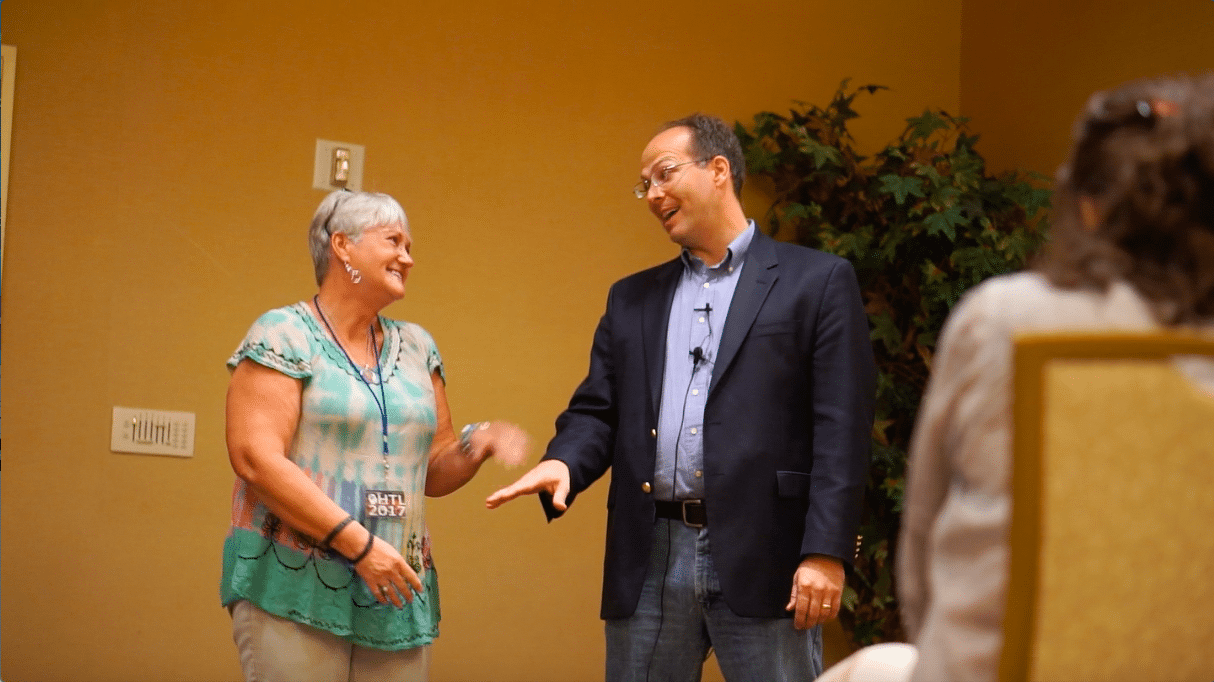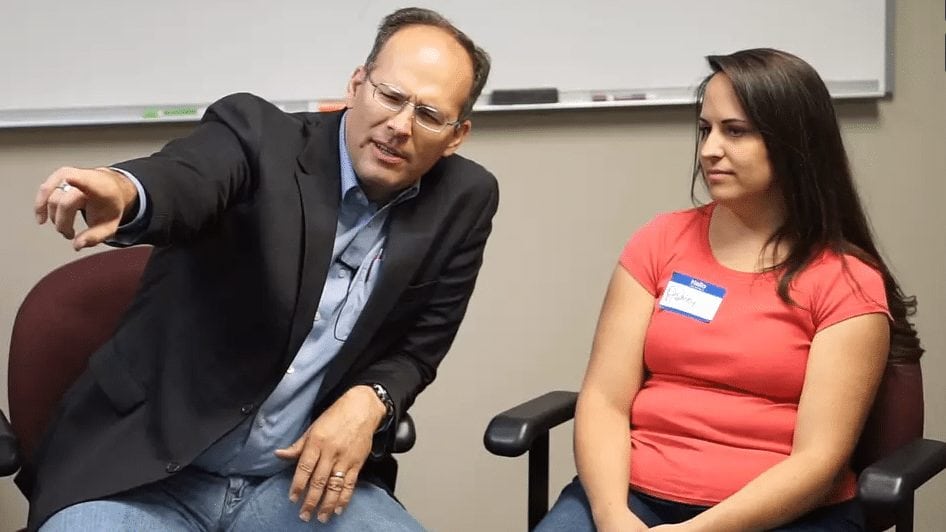
The Short Answer And The Long Answer:
Most people want to know how to know when the hypnosis has “worked.” There is a short answer and a long answer to this question. Here is the short answer: there are strong in-session “clues” that tell us when someone is making progress, but ultimately, I am sure a client has been victorious after they have created a new response or behavior in the real world.
For example, as of 2018, I have worked with more than 6,500 individuals in groups and in one on one sessions over about 18,000 sessions. During that time, most of my clients have been VERY satisfied with the REAL progress they have made between 4 and 10 sessions.
And everyone is a little different. So, to give you the best estimate possible about how many sessions you need and what your chances of success are, I need to chat with you and find out the details about your situation. When you are ready to take the next step forward, I recommend that you book a 20-minute consultation with me so that I can review your situation.
Call Vicki, my assistant, at 385-432-0729 (office), or 801-698-0752 (cell) when you are ready to book your consultation.
The article below is the somewhat longer answer to that same question: How Will I Know When My Sessions Are Done? This article was originally written for a prominent professional hypnosis magazine. This will help you better understand how I approach that question during my session work with my clients.
Enjoy.
Testing Your Work — How To Know When Your Work Is Done?
They All Disagreed and It Helped Me…
When I was a new hypnotist, I would watch one of my early teachers do an amazing piece of change work and I would marvel at what seemed to be a transformational experience.
Sometimes there was an outpouring of emotion, a type of therapeutic catharsis that was obvious to see. Yet sometimes the change was much more subtle. In fact there was almost no outward sign that anything had happened at all, but the client’s life was deeply and radically changed.
And so I watched these amazing examples of change. My teachers had an intuition about when the change happened, but as a new student, I didn’t quite have the same sense. So I would wonder as I was with a client doing to the work that needed to be done: “How do I know if the change is going to last?”
Change Cannot Be Measured By Tissue Consumption
For a little while I fell into the trap of measuring the efficacy of my hypnotic interventions by the amount of tissue consumed, the amount of tears that had been shed during the session until I found a more sophisticated way to evaluate change.
Fortunately for me, I was able to study with several of the most talented teachers in the industry–hypnotic artists who got consistent results–who disagreed with each other and challenged my views, forcing me to push the boundaries of my own thinking, forcing a synthesis of opposing ideas and allowing new ideas to emerge.
You MUST Do Things This Way If You Want Your Client To Change
In my first years of study, one skilled teacher would say, “The ONLY way to get a result is to do things THIS WAY.” And then the next teacher would condemn the very same technique that the last teacher recommended, saying, “NEVER do things THAT WAY or you won’t get results.” And yet both teachers seemed to demonstrate tremendous skill and to help people change profoundly.
Fortunately, I observed that no matter what any of my skilled teachers thought about how clients SHOULD change, clients simply decided to change anyway, sometimes in spite of the intervention used or the supposed theory behind it.
So How Do I Know IF A Client Has Changed…
Because I chose to study from a number of instructors with different opinions, I was left with my original quandaries for some time: “How do I know when a client has changed? How do I know that I have done enough work to get a result? And how do I know that the change will last?”
I finally came across several ideas that have radically influenced the way I think about change. Rather than focus in on techniques for change, I am going to spend some time outlining some of the principles of change that have been helpful for me in working with clients.
And I am going to make a bold claim: regardless of the change methodology that you use, these principles can help you help more people more often when you let them guide your work.
Principle #1: Ask Your Client How They Will Know They Have Changed or Make Sure You Establish Measurable Outcomes Before You Start Working
I practice in a VERY solution-focused way. I am practical. Generally speaking, before I do any change work with a client, I want to know what the client wants to change. That means I almost always let the client set the agenda for the session. That means when the client is presenting with a problem to solve that I need to know at least in broad terms what the client’s presenting problem is now AND I need to know what the client wants instead.
So imagine a client says to me in the first session, “My heart races when I speak in public.”
And I say, “Your heart races when you speak in public… What do you want things to be like after you leave today’s session and have completely changed?”
The client answers, “I want to NOT be afraid.”
And I respond, “You want to NOT be afraid. That is a good place to start. Imagine you are leaving my office today and you have left that old fear behind. That old fear is gone, so what ARE you experiencing now that you have changed?” The client pauses and then replies, “Well I am calm now that I am speaking and I feel really confident about myself.”
Now I ask the client for the evidence that lets him know that he has changed: “How do you know that you are calm now and feeling really confident about yourself?”
After the client answers, I follow up with the question to direct the client’s imagination to the other things he is noticing about his change experience: “Now that you are calm and feeling really confident, who else, outside of yourself, is the first person to notice that you have changed? [Pause to let the client respond.] And what is that person noticing about your change?
Sometimes, I will ask this question: “Is there anything else that would have to happen for you to know that the change is real and here to stay?”
7 out of 10 times, when you direct your client to their future, the client will tell me exactly what will have to happen in the real world to convince him that he has really changed.
The answers to these questions will help you and the client determine when the change has occurred. Additionally, getting the client to imagine the change will help build expectancy for the change to occur and sometimes is enough to effect the change in and of itself.
Principle #2: There is Imagination-Based Testing and Real World Testing of Results
Now let’s focus on the concept of testing. In my opinion, I want to continue to work with my client until the change the client wants is thoroughly tested in the office through the use of the client’s imagination (more on this in a minute).
If it is safe and appropriate to do, I also prefer to allow the client to test the change in the real world so that she knows that her change is real and lasting.
What do I mean when I talk about testing? I mean using imagination based methodologies and reality-based methodologies to determine if the client has made the change that they came in to see me about.
Let me explain a little more. There are two major ways to test a change. You can test the change in the client’s mind through the use of their imagination AND you can test a change in the real world, usually through some kind of gradual and intelligent exposure to old triggers in a safe and appropriate way.
CAUTION: This ASSUMES that the old trigger is SAFE and APPROPRIATE to test… some things should NEVER be tested in the real world for the client’s own safety or for the safety of others.
My experience with thousands of clients tells me that mind-based imagination testing is a good indication that progress has been made, but is not necessarily a guarantee that the change will automatically generalize into the client’s life and create easy new behavioral change.
Sometimes, a client misses something when testing in her imagination. Perhaps there is something in the environment that is out of the client’s awareness while she is in the office. However, this out of awareness stimulus IS an important component of the trigger for the old unwanted response.
For this reason alone, when it is safe and appropriate, I ask that the client perform some kind of real world test to ensure that any remaining components of the trigger have been completely released, before we move to the next phase of the change process.
But I never have the client test the change in reality UNTIL after they have passed all the in office, mind-based tests that are appropriate for their situation.
That means I ask the client to test the old problem in their mind first (more on this in a minute). Once the client tests the problem in the imagination, then we can proceed to reality-based testing, if appropriate.
Principle #3: You Can Test Your Work By Paying Attention To How People Look and Talk When They Discuss Their Problem Before AND After You Work With Them.
One of the easiest ways to test change in the office is to WATCH your client carefully as she talks about her problem or present state during the beginning of the session. Contrast the non verbal responses at the beginning of the session and the end of the session. I imagine I am mentally taking a short mental video and audio recording of the client at the beginning of the session so that I can contrast it with the end of the session.
While you observe your client, pay attention to her body language: especially note patterns in how her body posture, breath rate, color in their face and neck, patterns of eye movements, and gestures change and accentuate the words she chooses. Listen carefully to her voice tone and notice what words she emphasizes, especially when the voice slows down and gets really breathy and full sounding. But also notice any words that she marks out in any way — especially words that demonstrate a significant emotional change from the rest of her speech.
To carefully observe your client, you need to be looking at the client as she discusses her situation and goals, which means if you are taking notes, you need to look at her while she answers your questions. Without carefully observing and listening to your client, you miss the most important communication she gives you.
Often while the client is discussing her present state, the client will often repeat the same gesture, use the same voice tone, emphasize certain words, show evidence of a certain representational system (visual, auditory, feelings, etc), lock her eyes in the same exact location, have a subtle change in skin color around the nose, show the same micro-expression in her face, use the same words, etc. Make a mental note of these patterns at baseline so that you can contrast these unconscious patterns after you have done your work.
Every person will do this differently. Some people are really easy to read and others require more careful observation. Yet as you practice carefully watching your client, you will get better at noticing subtle behavioral cues.
After you do your healing ritual with your client, compare the client’s non verbal and verbal responses to their baseline responses. If the client still demonstrates the same body language, voice tone and and talks the same after your session is done, the problem has probably not changed and more work is indicated before the client moves to the next phase of testing.
On the other hand, the client looks, sounds and talks differently AFTER the healing ritual, there is a good chance that you have made significant forward progress and perhaps even changed the problem completely.
Certainly, it means you are ready to move your testing along to the next logical step.
 Principle #4: You Can Test Your Outcome by Asking Your Client To Scale His Progress
Principle #4: You Can Test Your Outcome by Asking Your Client To Scale His Progress
Another easy way to test change during the session is to ask the client to scale their progress. Before starting your healing ritual, ask your client scale the intensity of their problem on a 0-10 scale.
Imagine a client comes in for the fear of public speaking. I might say something like this: “As you imagine speaking in public now, how high would you rate your distress, on a scale of 0 to 10? Assume 10 represents being totally terrified and 0 represents calm and peaceful.”
If you use this kind of scaling system, I usually scale the problem BEFORE any change work has been done, so that there is a basis for comparison.
After doing your intervention, ask the client to scale their distress on the same scale and notice the response. Remember, the way the client answers your question with their non verbal responses will tell you more than WHAT NUMBER the client chooses.
Principle #5: You Can Test Your Work By Having The Client Think About The Past
Once a client reports ZERO distress, you can move on to the next phase of testing, which involves testing the client’s response in a number of different circumstances. An easy test involves testing other memories in the client’s past.
For example, imagine I am working with a client who has a fear of public speaking. Based on the changes in the client’s body language, voice tone and 0-10 response, it appears that the client has begun to change. So to continue testing, I can ask the following:
“Think about a time in the past when you had experienced a fear of public speaking… As you think about that experience, what do you notice now?”
After asking the question, I watch the client’s body language and listen carefully to the quality of her voice tone and notice if it has changed or if there are any sign of the old verbal or nonverbal response. Remember, if there is ever a conflict between the nonverbals or verbal responses, believe the nonverbal responses.
If the client responds with fear in the nonverbal responses, it is a clear sign that more work needs to be done.
One the other hand, if the client is demonstrating calm in her body and voice tone, I might ask a series of questions like these:
- “What is changing now?”
- “Are you sure?”
- “Wow, really?”
- “How do you know you are changing now?”
- “What does that mean about YOU?”
My goal is to help the client direct her awareness to the change and then link those change back into a newly consolidated set of beliefs about the world and her identity. I repeat a similar line of questioning every time the client reports that a change has been made. This is one of the most effective ways I know to help change generalize.
Once a memory has been tested and the client can ONLY find change and no residual problems are there, it is good to continue challenging the client to think of three to five additional examples (or more), until the client starts to convince me that the problem has, in fact, completely changed.
On the other hand if the client demonstrates any evidence that the problem is still intact, I use the memory as an opportunity continue performing healing rituals with the memory, so that the change now begins to generalize into other memories and contexts. This process can continue until the client finds no more thought or emotion evidence of the old state in her memory.
I repeat this process until the client is sure that he cannot find any more examples of the problematic response in his past.
Principle #6: You Can Test Your Work By Having The Client Imagine The Future
Just like you can use the past to expose attitudes, beliefs behaviors and triggers, you can leverage the client’s imagination to experience the future and do the same.
Let’s return to my client that asked for help with his fear of public speaking. From the intake interview, I know that he is going to be presenting at an upcoming safety meeting at work.
So I say, “Imagine your upcoming safety meeting at work. You are now standing in front of the group and it is time to present. What is happening now?”
I watch the body language and I listen to the verbal and nonverbal responses. Then I ask the scaling question… “If you were to rate your experience from 0-10, zero being totally calm, where are you now on that scale?”
If the client’s verbal or nonverbal responses report anything but total calm, I continue to perform healing rituals until the energy around the presentation completely dissolves. Once again, I continue to leverage future presentation with the client until the client starts to convince me that the change is complete.
Principle #7: You Can Use Ideomotor Responses To Test Your Work
Simply stated, ideodynamic responses are unconscious responses to thought.
Thought literally has the capacity to move the body (ideomotor response), to create sensory responses (ideosensory response), to create emotional responses (ideoaffective response), etc.
Often, with practice, you can learn to observe micro movements in the face or body, or changes in eye movements or changes in the color of the skin that let you know that the client is experiencing such responses.
Here is how you practice observing and catching these subtle responses.
Ask the client a series of yes/no questions that you are reasonably sure you know the answer to. Right before the client gives the conscious response for most people there is a patterned unconscious ideomotor movement that appears that will show their “yes” or “no.”
Once you learn to read your client’s subtle signals, you have a way to calibrate their unconscious responses.
Once you do, now you can ask your client a question like this one: “Now go inside and ask your unconscious mind if your old fear of public speaking is completely gone.”
The verbal answer that the client gives matters a little. The subtle nonverbal ideomotor response they give here matters a LOT. So pay careful attention to the first thing you observe after asking the question.
If you are not yet able to detect these subtle ideodynamic responses, then induce hypnosis, deepen and move the client to a peaceful place inside the mind. Once the client is there, establish ideomotor finger signals for “yes,” “no” and “I don’t know.” Then ask the client’s unconscious mind if the problem has been totally resolved and watch the movements carefully.
If we were using finger signals with our our fear of public speaking client, we might state, “Go inside and ask your unconscious mind if that old fear of public speaking that you used to have is now completely gone. Simply focus on the question and let your unconscious mind move the appropriate finger to give a response now.”
If the answer comes immediately, it MAY be conscious mind interference, often a genuine unconscious response comes after a moment’s pause and the caliber of the movement tends to look subtly different than the client’s normal conscious movements.
If there is a negative signal or if there is a conflicting signal (more than one finger signal moves), it is often a sign that there is more work indicated before real world testing is complete.
An “I don’t know” response may be a sign that there is more work to be done in terms of cleaning up old responses, or it may be a sign that the client’s mind is not yet convinced that the change is real or permanent and further inquiry is needed.
With any kind of mixed signal, I continue with the change work, encouraging the client to do more sessions until a clear ideomotor response is established for the change and the client’s conscious and unconscious mind becomes convinced the change has actually occurred. Often a client’s unconscious mind becomes aware of the change before the client’s conscious mind catches up that something is different. So some of my work involves helping the client convince her own conscious mind that the change that the unconscious mind has already observed.
There are other methods for ideodynamic testing that are beyond the scope of this article to discuss.
 Conclusion
Conclusion
This has been an overview of cognitive testing methods to determine if real world testing is safe and appropriate to undertake. We have reviewed seven principles for testing whether a client has changed as a result of the healing rituals you perform. While this is not an exhaustive list of all testing methods and principles, these ideas can greatly enhance your ability to assist your client to change her mind and bring that change into the real world. In my next article, I will be discussing two more principles related to testing the integrity of change work.
